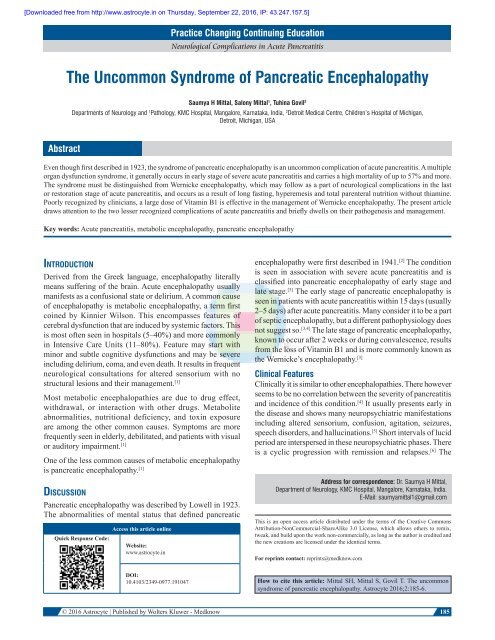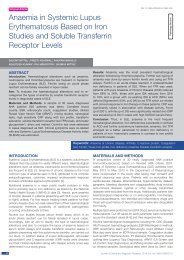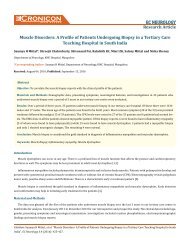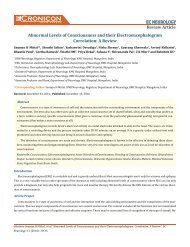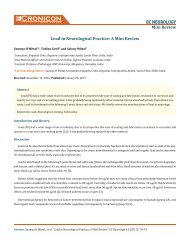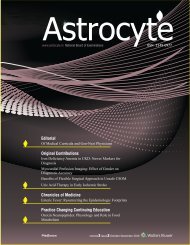The Uncommon Syndrome of Pancreatic Encephalopathy
You also want an ePaper? Increase the reach of your titles
YUMPU automatically turns print PDFs into web optimized ePapers that Google loves.
[Downloaded free from http://www.astrocyte.in on Thursday, September 22, 2016, IP: 43.247.157.5]<br />
Practice Changing Continuing Education<br />
Neurological Complications in Acute Pancreatitis<br />
<strong>The</strong> <strong>Uncommon</strong> <strong>Syndrome</strong> <strong>of</strong> <strong>Pancreatic</strong> <strong>Encephalopathy</strong><br />
Saumya H Mittal, Salony Mittal 1 , Tuhina Govil 2<br />
Departments <strong>of</strong> Neurology and 1 Pathology, KMC Hospital, Mangalore, Karnataka, India, 2 Detroit Medical Centre, Children’s Hospital <strong>of</strong> Michigan,<br />
Detroit, Michigan, USA<br />
Abstract<br />
Even though first described in 1923, the syndrome <strong>of</strong> pancreatic encephalopathy is an uncommon complication <strong>of</strong> acute pancreatitis. A multiple<br />
organ dysfunction syndrome, it generally occurs in early stage <strong>of</strong> severe acute pancreatitis and carries a high mortality <strong>of</strong> up to 57% and more.<br />
<strong>The</strong> syndrome must be distinguished from Wernicke encephalopathy, which may follow as a part <strong>of</strong> neurological complications in the last<br />
or restoration stage <strong>of</strong> acute pancreatitis, and occurs as a result <strong>of</strong> long fasting, hyperemesis and total parenteral nutrition without thiamine.<br />
Poorly recognized by clinicians, a large dose <strong>of</strong> Vitamin B1 is effective in the management <strong>of</strong> Wernicke encephalopathy. <strong>The</strong> present article<br />
draws attention to the two lesser recognized complications <strong>of</strong> acute pancreatitis and briefly dwells on their pathogenesis and management.<br />
Key words: Acute pancreatitis, metabolic encephalopathy, pancreatic encephalopathy<br />
Introduction<br />
Derived from the Greek language, encephalopathy literally<br />
means suffering <strong>of</strong> the brain. Acute encephalopathy usually<br />
manifests as a confusional state or delirium. A common cause<br />
<strong>of</strong> encephalopathy is metabolic encephalopathy, a term first<br />
coined by Kinnier Wilson. This encompasses features <strong>of</strong><br />
cerebral dysfunction that are induced by systemic factors. This<br />
is most <strong>of</strong>ten seen in hospitals (5–40%) and more commonly<br />
in Intensive Care Units (11–80%). Feature may start with<br />
minor and subtle cognitive dysfunctions and may be severe<br />
including delirium, coma, and even death. It results in frequent<br />
neurological consultations for altered sensorium with no<br />
structural lesions and their management. [1]<br />
Most metabolic encephalopathies are due to drug effect,<br />
withdrawal, or interaction with other drugs. Metabolite<br />
abnormalities, nutritional deficiency, and toxin exposure<br />
are among the other common causes. Symptoms are more<br />
frequently seen in elderly, debilitated, and patients with visual<br />
or auditory impairment. [1]<br />
One <strong>of</strong> the less common causes <strong>of</strong> metabolic encephalopathy<br />
is pancreatic encephalopathy. [1]<br />
Discussion<br />
<strong>Pancreatic</strong> encephalopathy was described by Lowell in 1923.<br />
<strong>The</strong> abnormalities <strong>of</strong> mental status that defined pancreatic<br />
Quick Response Code:<br />
Access this article online<br />
Website:<br />
www.astrocyte.in<br />
encephalopathy were first described in 1941. [2] <strong>The</strong> condition<br />
is seen in association with severe acute pancreatitis and is<br />
classified into pancreatic encephalopathy <strong>of</strong> early stage and<br />
late stage. [3] <strong>The</strong> early stage <strong>of</strong> pancreatic encephalopathy is<br />
seen in patients with acute pancreatitis within 15 days (usually<br />
2–5 days) after acute pancreatitis. Many consider it to be a part<br />
<strong>of</strong> septic encephalopathy, but a different pathophysiology does<br />
not suggest so. [3,4] <strong>The</strong> late stage <strong>of</strong> pancreatic encephalopathy,<br />
known to occur after 2 weeks or during convalescence, results<br />
from the loss <strong>of</strong> Vitamin B1 and is more commonly known as<br />
the Wernicke’s encephalopathy. [3]<br />
Clinical Features<br />
Clinically it is similar to other encephalopathies. <strong>The</strong>re however<br />
seems to be no correlation between the severity <strong>of</strong> pancreatitis<br />
and incidence <strong>of</strong> this condition. [4] It usually presents early in<br />
the disease and shows many neuropsychiatric manifestations<br />
including altered sensorium, confusion, agitation, seizures,<br />
speech disorders, and hallucinations. [5] Short intervals <strong>of</strong> lucid<br />
period are interspersed in these neuropsychiatric phases. <strong>The</strong>re<br />
is a cyclic progression with remission and relapses. [6] <strong>The</strong><br />
Address for correspondence: Dr. Saumya H Mittal,<br />
Department <strong>of</strong> Neurology, KMC Hospital, Mangalore, Karnataka, India.<br />
E‐Mail: saumyamittal1@gmail.com<br />
This is an open access article distributed under the terms <strong>of</strong> the Creative Commons<br />
Attribution‐NonCommercial‐ShareAlike 3.0 License, which allows others to remix,<br />
tweak, and build upon the work non‐commercially, as long as the author is credited and<br />
the new creations are licensed under the identical terms.<br />
For reprints contact: reprints@medknow.com<br />
DOI:<br />
10.4103/2349-0977.191047<br />
How to cite this article: Mittal SH, Mittal S, Govil T. <strong>The</strong> uncommon<br />
syndrome <strong>of</strong> pancreatic encephalopathy. Astrocyte 2016;2:185-6.<br />
© 2016 Astrocyte | Published by Wolters Kluwer ‐ Medknow 185
[Downloaded free from http://www.astrocyte.in on Thursday, September 22, 2016, IP: 43.247.157.5]<br />
Mittal, et al.: <strong>Pancreatic</strong> <strong>Encephalopathy</strong> - A Review<br />
patients may have features <strong>of</strong> a upper motor neuron lesion,<br />
but these are not always present. [5] <strong>The</strong>se signs include rigidity<br />
involving all 4 limbs, myalgias, and hyperreflexia. [6] Asterixis<br />
has been associated with the disease. [5]<br />
Pathogenesis<br />
In the early stage, the pancreatic enzymes enter the circulation.<br />
Phospholipase A2 converts encephalin and lecithin into highly<br />
cytotoxic hemolytic forms that damage the blood–brain barrier<br />
and also leads to vasogenic edema, demyelination, and neuronal<br />
damage (cell membrane and mitochondria). Intracerebral<br />
edema results secondary to increased intracerebral vascular<br />
permeability caused by platelet‐activating factor. [3,4,7]<br />
<strong>The</strong> inflammatory cytokines (in particular, tumor necrosis<br />
factor‐α, interleukin‐6 [IL‐6], IL‐8, and IL‐1β) involved<br />
in acute pancreatitis cause hypotension, hypoxia, and<br />
fat embolism, which may contribute to the delirium. [4,7]<br />
Oxygen‐free radicals cause cerebral injury. Swelling <strong>of</strong> the<br />
neurons and cerebral stroma may cause myelin cell degeneration<br />
and worsen with time. [7] This cytokine storm, in association<br />
with the entry <strong>of</strong> pancreatic enzymes into the central nervous<br />
system by the damage <strong>of</strong> the blood–brain barrier and<br />
hemodynamic dysfunctions associated with acute pancreatitis,<br />
forms the multifactorial basis <strong>of</strong> the pathogenesis <strong>of</strong> this<br />
encephalopathy. [5,7]<br />
<strong>The</strong> late stage <strong>of</strong> the pancreatic encephalopathy results due<br />
to low levels <strong>of</strong> Vitamin B1. Vitamin B1 deficiency causes<br />
decreased activity <strong>of</strong> transketolase. This precludes the<br />
oxygenation <strong>of</strong> pyruvic acid in the tricarboxylic acid cycle. [3,7]<br />
This malmetabolism leads to loss <strong>of</strong> recognition <strong>of</strong> function.<br />
This Wernicke’s encephalopathy was described in 1881<br />
by Carl Wernicke, who designated it as “polioencephalitis<br />
hemorrhagica superioris.” [2,7] If the diagnosis <strong>of</strong> pancreatic<br />
encephalopathy and Wernicke’s encephalopathy is to<br />
be cleared, diagnostic treatment may be attempted by<br />
administering 100 mg Vitamin B1 parenterally daily. On<br />
treatment, the latter would improve. [2]<br />
Laboratory data<br />
Routine blood investigations may be inadequate. In the<br />
presence <strong>of</strong> lack <strong>of</strong> reliable investigations, abnormal sugar<br />
curves may provide a clue to the diagnosis if the patient<br />
has psychotic symptoms such as anxiety neurosis and<br />
melancholia. [8] Cerebrospinal fluid shows a raised lipase level,<br />
but this is rarely tested. [4] Patchy white matter lesions are known<br />
in the condition, but the neuroradioimaging may be normal. [5]<br />
<strong>The</strong>se patchy white matter signal abnormalities may be seen<br />
in magnetic resonance imaging in the cerebral white matter<br />
and may resemble multiple sclerosis. Electroencephalogram<br />
changes are nonspecific and are not in correlation with the<br />
treatment or the course <strong>of</strong> pancreatitis. [2] Most commonly, a<br />
slowing <strong>of</strong> the waves is seen. [9] Histological examination <strong>of</strong><br />
the brain tissues show perivascular demyelination and diffuse<br />
petechiae. [6] <strong>The</strong> diagnosis is mainly one <strong>of</strong> the exclusions,<br />
and other causes <strong>of</strong> metabolic encephalopathy need to be<br />
ruled out. [5]<br />
Treatment<br />
<strong>The</strong>re is no specific treatment for this condition except<br />
supportive care and thiamine. [4] With proper treatment,<br />
recovery is uneventful among patients below 40 years <strong>of</strong><br />
age and may have sequel‐like cerebral infarction in elderly,<br />
especially those above 60 years <strong>of</strong> age. [2]<br />
If recognition and treatment are delayed, there may be<br />
devastating neurological outcome. [9] <strong>Pancreatic</strong> encephalopathy<br />
carries a high mortality. <strong>The</strong> causes <strong>of</strong> death include shock,<br />
ketoacidosis, and multiorgan dysfunction syndrome.<br />
On autopsy, the patients show pinpoint hemorrhages in<br />
multiple areas <strong>of</strong> brain such as hypothalamus, thalamus, and<br />
mammillary bodies. [2]<br />
Financial support and sponsorship<br />
Nil.<br />
Conflicts <strong>of</strong> interest<br />
<strong>The</strong>re are no conflicts <strong>of</strong> interest.<br />
References<br />
1. Katramados A, Varelas P. <strong>Encephalopathy</strong>. In: Torbey M, editor.<br />
Neurocritical Care. Cambridge: Cambridge University Press; 2010.<br />
p. 220‐6.<br />
2. Sun GH, Yang YS, Liu QS, Cheng LF, Huang XS. <strong>Pancreatic</strong><br />
encephalopathy and Wernicke encephalopathy in association with acute<br />
pancreatitis: A clinical study. World J Gastroenterol 2006;12:4224‐7.<br />
3. Ding X, Liu CA, Gong JP, Li SW. <strong>Pancreatic</strong> encephalopathy in<br />
24 patients with severe acute pancreatitis. Hepatobiliary Pancreat Dis<br />
Int 2004;3:608‐11.<br />
4. Weathers AL, Lewis SL. Rare and unusual... or are they? Less commonly<br />
diagnosed encephalopathies associated with systemic disease. Semin<br />
Neurol 2009;29:136‐53.<br />
5. Sharma V, Sharma R, Rana SS, Bhasin DK. <strong>Pancreatic</strong> encephalopathy:<br />
An unusual cause <strong>of</strong> asterixis. JOP 2014;15:383‐4.<br />
6. Sharf B, Bental E. <strong>Pancreatic</strong> encephalopathy. J Neurol Neurosurg<br />
Psychiatry 1971;34:357‐61.<br />
7. Zhang XP, Tian H. Pathogenesis <strong>of</strong> pancreatic encephalopathy in severe<br />
acute pancreatitis. Hepatobiliary Pancreat Dis Int 2007;6:134‐40.<br />
8. Rothermich NO, Von Haam E. <strong>Pancreatic</strong> encephalopathy. J Clin<br />
Endocrinol Metab 1941;1:872‐81.<br />
9. Ramanathan RS, Ahluwalia T. Acute necrotizing pancreatitis leading to<br />
pancreatic encephalopathy in a patient undergoing long‐term continuous<br />
ambulatory peritoneal dialysis. J Acad Med Sci 2012;2:85‐7.<br />
186<br />
Astrocyte ¦ Jan-Mar 2016 ¦ Volume 2 ¦ Issue 4


